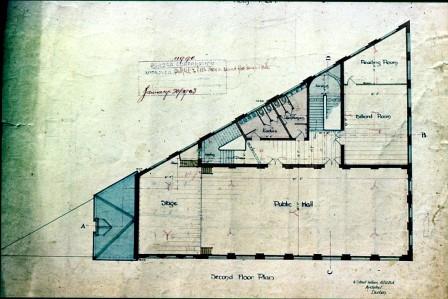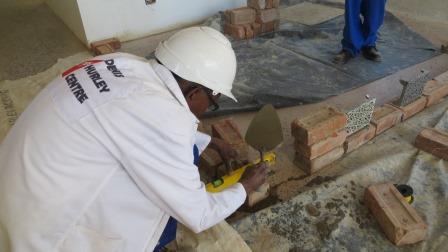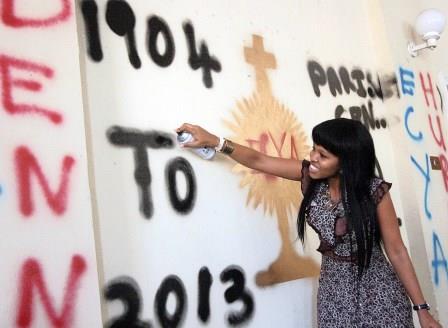
| The site was purchased by Bishop Charles Constant Jolivet OMI from Moosa Hajee Cassim on 27 April 1901 for 4,000 pounds. |

| Although intended to be a parish centre when it was built alongside the Cathedral and Presbytery in the early 1900s (one of the first events held in the hall was a farewell reception for Bishop Henri Delalle in 1906 when he was on his way overseas), it soon became the original site of St Augustine’s School. |
| St Augustine's School |
|

| According to Sr Denise Boardman HF, the Holy Family archivist, a new Convent School was built in St Andrew’s Street (the building that is now the Diakonia Centre). When this school became too crowded, and possibly as a result of pressure from white parents, it was decided that a separate school should be established for Coloured children at the Cathedral.
|
St Augustine’s developed and prospered as a school on this tiny site, with very little outdoor space for recreation.It was by no means an ideal venue for a school, the Principal having to make use of one of the landings as her office and the pupils’ playground being what was then known as Cemetery Lane.
According to the Souvenir Brochure published for St Augustine’s 75th Anniversary in 1982, the school was started in 1907 and continued on this site probably until 1957 when it reopened in a new and much larger set of buildings with space for playgrounds and sports fields in Sydenham Road opposite the Greyville Race Course.
The 1982 Souvenir Brochure contains a message from Archbishop Hurley in which he recounts vivid memories of the school from the period 1940 – 1944 when he was the Junior Curate at Emmanuel Cathedral:
In those days the playground for the school was Cemetery Lane and what a buzzing, stirring scene that was during lunch break. Every possible game seemed to be happening in the narrow space and the joyous sounds rose to the heavens like a nuclear explosion. I used to add to the buzz and the explosion when I returned from my parish visits on a motor cycle. It was a small one, a Francis Barnett two-stroke, if that means anything to anyone today. Cheers often greeted our arrival. I suspect that the cheers were more for the motor cycle than for me. There is a natural sympathy for the underdog. Those were very happy days for me on my first pastoral assignment as the most junior curate at the Cathedral. They seemed to be happy days for St Augustine’s too, though it was dreadfully cramped and crowded in the narrow confines of the Cathedral Centre and Cemetery Lane. Shortly afterwards the school moved to its magnificent new premises on Sydenham Road. That made things much easier for the school but we missed the lovely community of Holy Family Sisters, lay teachers and exuberant pupils from the neighbourhood of the Cathedral.
|
 ![]()
| Students from St Augustine’s now in their 60s, 70s and 80s remember fondly their school days in the old building. They have been especially supportive in fund-raising for the Denis Hurley Centre. One way in which a link to the old building is retained is in the use on the 1st floor of bricks, iron work and wooden stair bannisters, incorporated into the new Denis Hurley Centre by a retired Master Builder, Tony Stals, who was a pupil at the school 60 years ago. The 1st floor cafe is named 'St Augustine's Cafe' and will contain a tribute to the pupils and staff of the school. |
The Parish Centre |

| It seems that throughout the life of the Parish Centre, including the nearly 50 years that it was used for St Augustine’s School, it was the venue for the Cathedral’s catechism classes. Archbishop Hurley also recalled another parish use of the building: he played badminton in the hall in the early 1940s with Cathedral parishioners. It seems likely that in a number of ways the buildings were used both by the school and the parish. |
In 1949, by which time Father Hurley had succeeded Bishop Delalle as Vicar Apostolic of Natal, his first experience of intervening in a socio-political crisis had consequences for St Augustine’s School.
During the Zulu-Indian conflict which erupted in central Durban and rapidly spread to other parts of the city, families living in Grey Street (now Yusuf Dadoo) came to the Cathedral to ask for temporary refuge. The young Bishop Hurley arranged for them to be accommodated in St Augustine’s School, persuading the rather reluctant Holy Family Sisters who no doubt feared the disruption of the good order of their school.
Though Archbishop Hurley missed the liveliness of the school when it moved, the Emmanuel Cathedral parish must have welcomed having the whole building for its use as a Parish Centre from 1956/7 onwards. It provided space for catechism classes on Sundays, and, in addition, for innumerable meetings of sodalities and other parish and diocesan organisations, for concerts, plays, dances, parish socials and receptions.
With the strong backing of Archbishop Hurley, night schools were established here and flourished for many years in the 1960s, 70s and 80s despite the fact that they flouted apartheid laws. As a result of the educational opportunities provided in this way, many students were able to complete their matric while working in central Durban.
The building also provided office accommodation for many years for the Catholic African Organisation (CAO) under the energetic leadership of Fr Howard St George OMI.
More recently, other social outreach projects found a home here making excellent use of cramped and dilapidated spaces: Refugee Pastoral Care, Nkosinathi (feeding scheme), Usizo Lwethu (clinic), Justice, Peace and Development (paralegal support and job-related training).
Emmanuel Cathedral parish continued to grow rapidly and its social outreach programmes expanded to assist over 6,000 people a month.
Inevitably, such an old building being used by so many people saw a deterioration in its state of repair. The idea of renovating the Parish Centre was discussed for a number of years. The Cathedral itself was refurbished from 1999, and the Presbytery in 2004, so it seemed obvious that something would have to be done about the run-down Parish Centre.
Had the time come to provide a purpose-built facility where these social outreach projects could flourish and be a beacon of hope in a challenging neighbourhood?
|
|
A new building for a new centre?
In August 2008, Fr Stephen Tully, the Cathedral Administrator, invited parishioners to come together to consider options. About 40 parishioners responded with great enthusiasm to the Father Stephen’s dream of creating a Denis Hurley Centre at the Cathedral. A number of teams were established to take the idea forward and to survey all the users of the existing Parish Centre about the needs of their groups. The results were collated and put in the briefing document for the architects.

A great crowd of all races and religions gathered at the Cathedral on Sunday 15 February 2009 – the weekend of the 5th year anniversary of the death of Denis Hurley – for the official launch of a fundraising drive by Cardinal Wilfrid Napier OFM. The Denis Hurley Centre Board had its first meeting in June 2009 and was later replaced in June 2010 by the Denis Hurley Centre Trust which is registered as an NPO (Non Profit Organisation) and as a PBO (Public Benefit Organisation).
In October 2009, the firm Ruben Reddy Architects was appointed to draw up plans for the refurbishment of the Parish Centre which was C-listed in terms of its heritage quality. However, when these plans were costed by the Quantity Surveyor, Davis Langdon, it was found that refurbishing would be prohibitively expensive, likely to be more than double the cost of a new building with the same floor area. It was therefore decided by the Archdiocesan Building Committee that a new building should be commissioned.
This required that the existing centre would first be demolished. For that permission was needed from Amafa, the heritage council for KwaZulu-Natal. The permit was secured and the old building demolished in 2013 but not without ceremony. Parishioners and past pupils of St Augustine’s came along to say farewell to a building that had been so much a part of their lives and they inscribed their memories in the building with graffiti. As the walls of Jericho came tumbling down only after being circled by trumpets, so the demise of the old Parish Centre was heralded by the sounding of vuvuzelas.

But in the period between pulling down the old building and completing the new one, all the parish and community activities continued with almost no gap. This was thanks to the agreement that we could rent the nearby Surat Building from the Hindu Trust that owns it. Such a move thus provided a practical demonstration of the commitment to continue Denis Hurley’s interfaith work.
Approval having been obtained from the Archdiocese and eThekwini Municipality, building work commenced in August 2013 and in February 2014 (the 10th anniversary of Hurley’s death) the foundation stone was unveiled by the Cardinal and other patrons representing a range of religious groups.
In the end over R32.5 million was raised to construct the building under the supervision of Greg Hayhoe, of GVK Construction. On 11 December 2014, a ceremonial key was handed over to the Cardinal and a more practical bunch of 200 keys to the Centre Manager, Jean-Marie Ntamubano and the building officially became the Denis Hurley Centre.
In the meantime, the Sacred Heart Sodality had funded and commissioned a magnificent bronze near life-size statue of the Archbishop. This had been waiting in the Cathedral bell tower until it was placed in a prominent position on the ground floor of the Centre and on the day of the handover was unveiled by the widow of the sculptor, Reg Stroh, by Cecilia Mkhize, President of the Sacred Heart Sodality at the time the funds were collected for the statue, and by Mikaela York, one of the nieces of Denis Hurley.
One of the central objectives of the new building was to provide a range of flexible facilities to help make the project financially sound. Finishes and surfaces were selected to ensure the lowest maintenance costs. Special lighting systems and natural lighting combinations prevented wasteful use of electricity. In addition, users and tenants are levied to cover the costs of running the Centre.
In January 2015, the key outreach projects – which had carried on their work uninterrupted during the construction phase – moved in to the new Centre. The new building was officially opened on 9 November 2015, what would have been Archbishop’s Hurley’s 100th birthday. What better birthday present to give him?